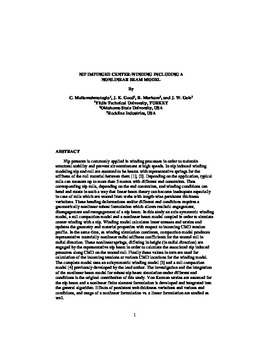| dc.contributor.author | Mollamahmutoglu, C. | |
| dc.contributor.author | Good, J. K. | |
| dc.contributor.author | Markum, R. | |
| dc.contributor.author | Gale, J. W. | |
| dc.contributor.other | International Conference on Web Handling (2017) | |
| dc.date.accessioned | 2019-11-13T20:00:25Z | |
| dc.date.available | 2019-11-13T20:00:25Z | |
| dc.date.issued | 2017-06 | |
| dc.identifier | oksd_icwh_2017_mollamahmutoglu | |
| dc.identifier.citation | Mollamahmutoglu, C., Good, J. K., Markum, R., & Gale, J. W. (2017, June). Nip impinged center-winding including a nonlinear beam model. Paper presented at the Fourteenth International Conference on Web Handling (IWEB), Stillwater, OK. | |
| dc.identifier.uri | https://hdl.handle.net/11244/322055 | |
| dc.description.abstract | Nip pressure is commonly applied in winding processes in order to maintain structural stability and prevent air entrainment at high speeds. In nip induced winding modeling nip and roll are assumed to be beams with representative springs for the stiffness of the roll material between them [1], [2]. Depending on the application, typical rolls can measure up to more than 5 meters with different end constraints. Thus corresponding nip rolls, depending on the end constraints, and winding conditions can bend and rotate in such a way that linear beam theory can become inadequate especially in case of rolls which are wound from webs with length-wise persistent thickness variations. These bending deformations and/or different end conditions requires a geometrically nonlinear robust formulation which allows realistic engagement, disengagement and reengagement of a nip beam. In this study an axis-symmetric winding model, a roll compaction model and a nonlinear beam model coupled in order to simulate center-winding with a nip. Winding model calculates inner stresses and strains and updates the geometry and material properties with respect to incoming CMD tension profile. In the same time, as winding simulation continues, compaction model produces representative materially nonlinear radial stiffness coefficients for the wound roll in radial direction. These nonlinear springs, differing in height (in radial direction) are engaged by the representative nip beam in order to calculate the associated nip induced pressures along CMD on the wound roll. Finally these values in turn are used for calculation of the incoming tensions at various CMD locations for the winding model. The complete model uses an axisymmetric winding model [3] and a roll compaction model [4] previously developed by the lead author. The investigation and the integration of the nonlinear beam model for robust nip beam simulation under different end conditions is the original contribution of this study. Von Karman strains are assumed for the nip beam and a nonlinear finite element formulation is developed and integrated into the general algorithm. Effects of persistent web thickness variations and various end conditions, and usage of a nonlinear formulation vs. a linear formulation are studied as well. | |
| dc.format | application/pdf | |
| dc.language | en_US | |
| dc.publisher | Oklahoma State University | |
| dc.rights | In the Oklahoma State University Library's institutional repository this paper is made available through the open access principles and the terms of agreement/consent between the author(s) and the publisher. The permission policy on the use, reproduction or distribution of the article falls under fair use for educational, scholarship, and research purposes. Contact Digital Resources and Discovery Services at lib-dls@okstate.edu or 405-744-9161 for further information. | |
| dc.title | Nip impinged center-winding including a nonlinear beam model | |
| osu.filename | oksd_icwh_2017_mollamahmutoglu.pdf | |
| dc.description.department | Mechanical and Aerospace Engineering | |
| dc.type.genre | Conference proceedings | |
| dc.type.material | Text | |
